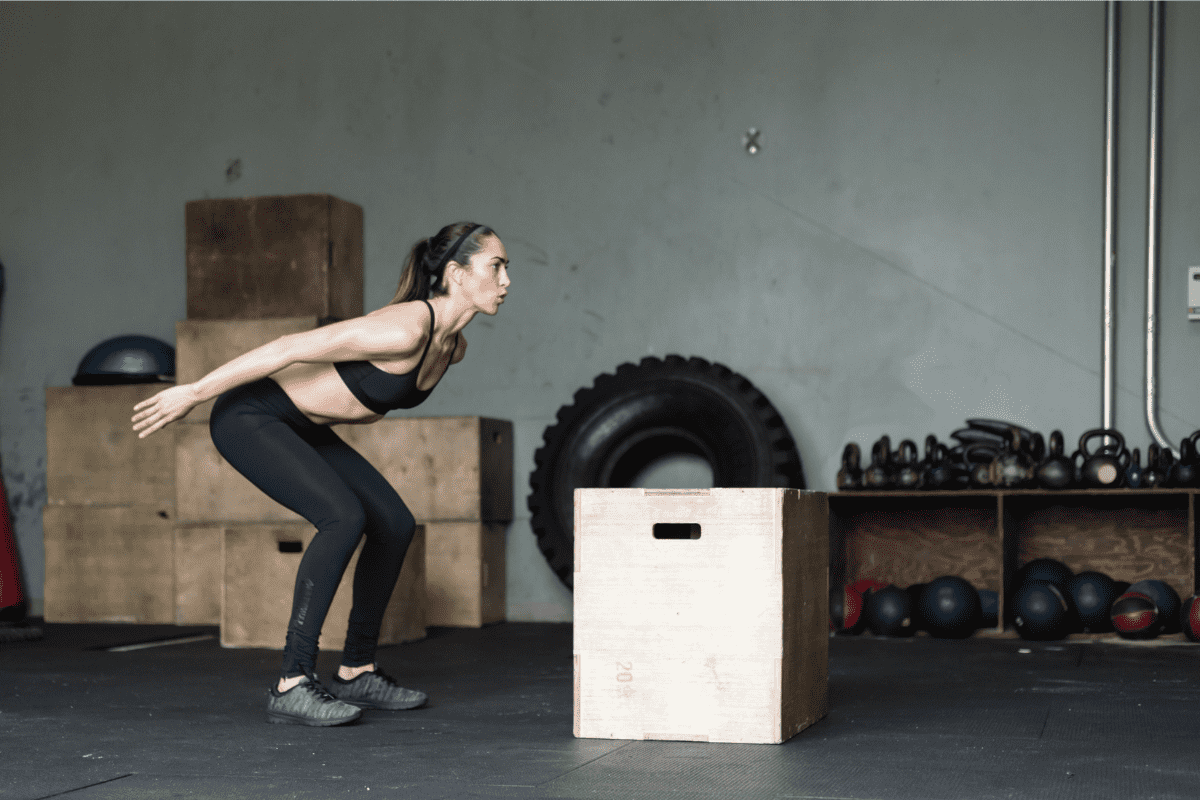Box Jumps (How To, Muscles Worked, Benefits)
Box Jumps are probably the most popular and well-known plyometric exercise. And for good reason too.
Having a box to jump to helps athletes have a focused height to consistently jump to. Having a box to land on also takes away a lot of the pounding that would occur if the athlete had to land back on the ground each rep.
In this guide, I’m going to teach you how to do Box Jumps along with specific coaching points to pay attention to. Finally, I’ll also give you a few alternatives in case you don’t have a box for Box Jumps.
How To Do Box Jumps
Equipment Needed
- Plyo Box
Step-by-Step Instructions
- Grab a box that is the proper height for your jumping ability
- Start just far enough away from the box so that your hands will not hit the box when you swing them.
- Once you’re in position, stand tall with feet hip-width apart.
- Now raise your arms overhead and extend up onto the balls of the feet.
- Start your countermovement by hinging at the hips, bending the knees and throwing the hands down and back behind the body.
- Immediately redirect by driving the feet through the floor, throwing the hands up and triple extending through the hips, knees and ankles.
- Land softly on the box by bending the knees upon landing and absorbing the force of impact.
- Step down off the box and repeat.
Coaching Points
Pick a box that is an appropriate height. You should land on the box in roughly a quarter-squat position. All too often I see athletes jump on a box that is way too high, causing them to have to land in a full squat position.
This is wrong for two reasons. First, picking your feet higher so you can land in a full squat doesn’t actually mean you jump any higher. Second, having to land in a full squat to make it onto the box eliminates any room for error. If you jump perhaps even an inch not high enough you could end up missing the box.
Don’t stand too far away from the box or you’ll end up jumping at the box instead of up onto the box. This horizontal trajectory can make landing and stabilizing on the box tricky.
Always land with your feet completely on the box. If you get in the habit of landing on the edge of the box and you miss a little, you’ll end up with your shins into the edge of the box.
If you haven’t bought a box yet for your home gym, you’ll have to decide whether you want a soft foam box or a wooden box. Both have their pros and cons. It just depends on which is the better fit for you and your gym.
Benefits of Box Jumps
Some specific benefits of Box Jumps include:
- Improved lower body strength: Box jumps involve jumping from a standing position onto a box or platform, which requires strength in the legs and hips. Regularly performing box jumps can help improve lower body strength and power.
- Increased coordination: Box Jumps require coordination in order to land on the box with proper form. Practicing box jumps can help improve coordination and balance.
- Enhanced athletic performance: Box Jumps can help improve explosive power, which is important in many sports and activities that require quick bursts of energy, such as sprinting and jumping. (It’s why they are one of my favorite exercises for basketball players)
- Cardiovascular conditioning: Box Jumps can be performed as part of a high-intensity interval training (HIIT) circuit, which can help improve cardiovascular endurance. Just be VERY careful when jumping up to a box in a fatigued state that you’re still able to safely jump on the box each rep.
- Improved bone density: Plyometric exercises like Box Jumps can help improve bone density, which can reduce the risk of osteoporosis and other bone-related conditions.
Box Jump Alternatives
Don’t have a box to jump onto? No worries. Here are a few alternatives you may be able to do instead.
Vertical Jumps
Training doesn’t always have to be complicated. If you don’t have a box to jump onto, you can always just do Vertical Jumps. Jump straight up into the air as high as possible and land in the same place.
The only downside to doing vertical jumps is that the body has to absorb much more force upon landing. So, don’t get carried away with too many reps but doing a few sets in a workout shouldn’t be an issue for most athletes.
Tuck Jumps
If you want to increase the challenge of a Vertical Jump as well as simulate driving the legs up like you would be landing on a box – try Tuck Jumps.
Tuck Jumps are simply Vertical Jumps where you drive your knees up into your chest at the peak of your jump. Other than that, the start and the landing are exactly the same.
More Links and Info
If you’d like to see more Plyometric movements, make sure to check out the Plyo Section of our Exercise Library.

